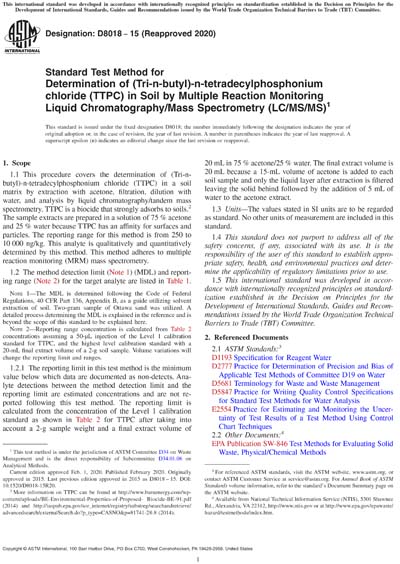Most recent
ASTM D8018-15(2020)
Standard Test Method for Determination of (Tri-n-butyl)-n-tetradecylphosphonium chloride (TTPC) in Soil by Multiple Reaction Monitoring Liquid Chromatography/Mass Spectrometry (LC/MS/MS)
1.1 This procedure covers the determination of (Tri-n-butyl)-n-tetradecylphosphonium chloride (TTPC) in a soil matrix by extraction with acetone, filtration, dilution with water, and analysis by liquid chromatography/tandem mass spectrometry. TTPC is a biocide that strongly adsorbs to soils.2 The sample extracts are prepared in a solution of 75 % acetone and 25 % water because TTPC has an affinity for surfaces and particles. The reporting range for this method is from 250 to 10 000 ng/kg. This analyte is qualitatively and quantitatively determined by this method. This method adheres to multiple reaction monitoring (MRM) mass spectrometry.
1.2 The method detection limit (Note 1) (MDL) and reporting range (Note 2) for the target analyte are listed in Table 1.
Note 1: The MDL is determined following the Code of Federal Regulations, 40 CFR Part 136, Appendix B, as a guide utilizing solvent extraction of soil. Two-gram sample of Ottawa sand was utilized. A detailed process determining the MDL is explained in the reference and is beyond the scope of this standard to be explained here.
Note 2: Reporting range concentration is calculated from Table 2 concentrations assuming a 50-μL injection of the Level 1 calibration standard for TTPC, and the highest level calibration standard with a 20-mL final extract volume of a 2-g soil sample. Volume variations will change the reporting limit and ranges.
1.2.1 The reporting limit in this test method is the minimum value below which data are documented as non-detects. Analyte detections between the method detection limit and the reporting limit are estimated concentrations and are not reported following this test method. The reporting limit is calculated from the concentration of the Level 1 calibration standard as shown in Table 2 for TTPC after taking into account a 2-g sample weight and a final extract volume of 20 mL in 75 % acetone/25 % water. The final extract volume is 20 mL because a 15-mL volume of acetone is added to each soil sample and only the liquid layer after extraction is filtered leaving the solid behind followed by the addition of 5 mL of water to the acetone extract.
1.3 Units—The values stated in SI units are to be regarded as standard. No other units of measurement are included in this standard.
1.4 This standard does not purport to address all of the safety concerns, if any, associated with its use. It is the responsibility of the user of this standard to establish appropriate safety, health, and environmental practices and determine the applicability of regulatory limitations prior to use.
1.5 This international standard was developed in accordance with internationally recognized principles on standardization established in the Decision on Principles for the Development of International Standards, Guides and Recommendations issued by the World Trade Organization Technical Barriers to Trade (TBT) Committee.
Content Provider
ASTM International [astm]






